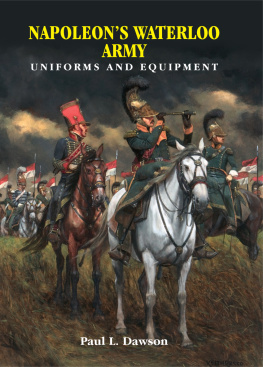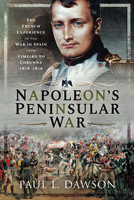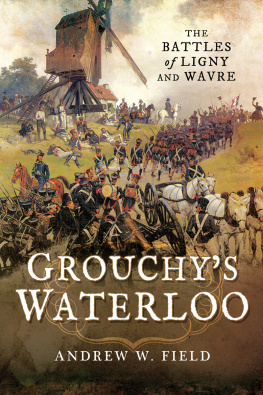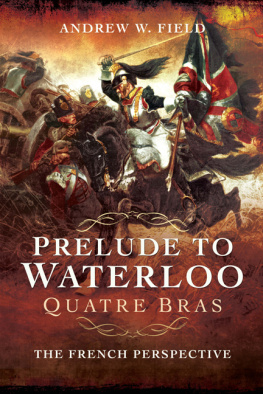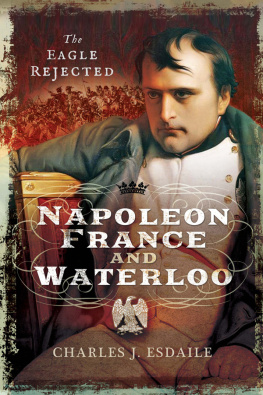Napoleons Waterloo Army
UNIFORMS AND EQUIPMENT
First published in Great Britain in 2019 by Frontline Books, an imprint of Pen & Sword Books Ltd, Yorkshire - Philadelphia
Copyright Paul L Dawson
Colour plates copyright Keith Rocco
ISBN: 978-1-52670-528-0
eISBN: 978-1-52670-530-3
Mobi ISBN: 978-1-52670-529-7
The right of Paul L Dawson to be identified as Author of this work has been asserted by him in accordance with the Copyright, Designs and Patents Act 1988. A CIP catalogue record for this book is available from the British Library
All rights reserved.
No part of this book may be reproduced or transmitted in any form or by any means, electronic or mechanical including photocopying, recording or by any information storage and retrieval system, without permission from the Publisher in writing.
Pen & Sword Books Ltd incorporates the imprints of Pen & Sword Archaeology, Air World Books, Atlas, Aviation, Battleground, Discovery, Family History, History, Maritime, Military, Naval, Politics, Social History, Transport, True Crime, Claymore Press, Frontline Books, Praetorian Press, Seaforth Publishing and White Owl.
For a complete list of Pen & Sword titles please contact:
PEN & SWORD BOOKS LTD
47 Church Street, Barnsley, South Yorkshire, S70 2AS, UK.
E-mail:
Website: www.pen-and-sword.co.uk
Or
PEN AND SWORD BOOKS,
1950 Lawrence Road, Havertown, PA 19083, USA
E-mail:
Website: www.penandswordbooks.com
ACKNOWLEDGEMENTS
In the preparation of this book I would like to thank all those who have offered advice and support, and all those who have helped me with my research. I never planned to write on Waterloo, and at long last this is my fourth, but possibly not my last, volume on the battle.
Can any more new light be shed on the battle? Not another Waterloo book, many will say, but this book is different to all those written before. The book provides a fitting second part and conclusion to Waterloo: The Truth at Last . The book presents in minute detail what the Arme du Nord wore, who the officers and men were, what their loyalties were, and above all, what happened to them. The book is the culmination of over ten years of research in French and British archives.
My friend, Keith Rocco, must be thanked for his wonderful illustrations. We have spent many hundreds of hours discussing Waterloo, the battle, its men and above all, debating the uniforms. He has brought my research splendidly to life in his twenty-one images he has created for this book.
Thanks also to Captain Sbrava, of the Service Historique de la Dfense Arme de Terre, for granting me unique access to regimental muster lists that have been off limits to researchers due to the poor condition of these documents. Permission was granted at the time of Waterloo: The Truth at Last going to press, so the details of these documents are presented in this work, along with comments on the fate of the men at Waterloo. H. Jean Charles Lair is to be thanked for his help in transcribing the contents of these documents for me.
Isabelle Artaud, of the Muse de lArme, Paris, is also to be heartily thanked for providing me with permission to use images of the collections of the Muse de lArme.
Furthermore, I am indebted to my research consortium of Ian James Smith, John Lubomski and Sally Fairweather for their assistance with, and photographing of archival material at the Archives Nationales and Service Historique de la Dfense Arme de Terre in Paris. Without their help, this book could not have been written. We have spent many hundreds of hours in Paris, and without their help, the work in collecting the research material would have taken far longer than the four years it has taken already.
I must also acknowledge the tremendous and most generous assistance in the provision of research material by Ronald Pawly, and Yves Martin for the digital images of material at the Archives Nationales and Service Historique de la Dfense Arme de Terre. Ronald has been of great help in our many hours of discussions and debates on the campaign, and sources available to researchers. Bravo gentlemen.
Pierre de Wit needs to be thanked for his assistance, and I urge readers to his excellent online study of the campaign. Professor A. Pollard needs to be thanked for his friendship and ongoing support of my work on Waterloo.
My twin brother must be thanked for his excellent research on the bands and sapeurs of the Old Guard in 1815. His research shows what incredible archive materials exist to flesh out the men of the Arme du Nord and their careers as soldiers.
I must single out Ian Smith for his friendship, dedicated support to the project, and excellent company during our numerous research trips to Paris. His advice and guidance during our many thousands of hours of conversations over numerous bottles of red wine was, and is, of immense guidance in understanding the wealth of data that we have gathered, to synthesise it into a cohesive narrative.
Without this most generous support by Ian, the book would have taken far longer to complete.
Marie Galvez, head of Collection de lOffice de Tourisme de Pontarlier, of the Dpt au Muse Municipal de Pontarlier, must be thanked for permission to reproduce images of the amazing collection the town holds. I heartily recommend a visit to this museum at Fort de Joux.
Jerome Croyet must be thanked for his permission to reproduce the photographs I have taken of the former Brunon collection. He is also to be thanked for provision of research notes. Also, to be thanked is Bertrand Malvaux for permission to use images of items in his collection.
I am indebted to Miss Rachal Cresswell BA (Hons) PGCE and Mrs Emily Lancaster BSc MSc for their help in the preparation of the text.
Lastly, the long-suffering staff at the Service Historique de la Dfense Arme de Terre in Paris need to be thanked for answering questions and locating items of research that have made this, the fourth volume in my series of books on the campaign of Waterloo, possible.
FOREWORD
Tony Pollard
Professor of Conflict History and Archaeology, University of Glasgow
Among the many striking features of the Napoleonic Wars were the ornate uniforms worn by the protagonists. To modern eyes, the dashing attire of some of those troops might seem more suited to the fancy dress party than the battlefield. It was of course Wellington who, after the Battle of Waterloo, opined that one might as well write the history of a ball as a battle (perhaps taking the Duchess of Richmonds ball, hosted just before Waterloo, as the inspiration for his analogy). He was of course having a crack at historians, belittling their efforts to subject the chaos and horror of combat on such a grand scale to detailed, almost microscopic analysis. The reality, as he knew, was that no one is capable of such close grained comprehensions. The perspective of the soldier on the battlefield is limited to the deadly swirl of activity to his immediate front, and to the actions of the men posted at each shoulder, especially when the dense clouds of white smoke belched out by thousands of muskets creates the fog of war.
It was during the duchesss ball that the Duke of Wellington learned of Napoleons advance into Belgium, as this part of the Low Countries was to become. Within twenty-four hours, the Battles of Quatre Bras and Ligny would pitch Anglo-Dutch forces under Wellington against the left wing of the French Arme du Nord under Marshal Ney at the former, and the Prussians under Blcher against Napoleon with the main body of the French force at the latter. All sides suffered in these bruising engagements, but it was the Anglo-Dutch and Prussian armies that retreated north, with the French hot on their heels, though the turn of phrase does flattery to the speed at which Napoleon took up the chase. Wellington halted his army at Waterloo, where famously he had spotted a strong defensive position on the heights of Mont St Jean some months previously. The Prussians, determined to see their job through, defied French hopes, if not expectations, by moving to join their allies rather than turn east and head for home.

